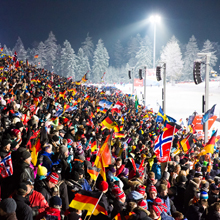 |
| Schilling and his team relied on 30 EV XLD281 line array elements, split between five arrays of six modules each |
From the 8th to the 13th January, this season’s Biathlon World Cup was contested in the Chiemgau Arena in Ruhpolding, Germany. During the five days of competition, some 70,000 spectators visited the village in Upper Bavaria to watch the world’s elite biathletes in action.
For several years now, the Traunstein-based firm of Musik Mayer has been employed as general contractor whenever the Biathlon World Cup has visited Ruhpolding. They, in turn, commissioned MSE-Tontechnik GmbH of Stubenberg in Lower Bavaria to plan and implement the sound reinforcement for the main grandstand. The main grandstand of the Chiemgau Arena recently underwent a major refurbishment in time for the 2012 Biathlon World Championships and now extends for 135 metres, seating 13,000 spectators. The latter, according to MSE’s managing director, Johannes Schilling, have come to expect not only commentary that it is intelligible but also musical reproduction with plenty of punch and transparency to enjoy during the intervals between competitions. “Quite aside from the sound quality they provide,” he continues, “any loudspeakers used here have to be weatherproof to a very high degree, as there are often extreme variations in temperature. All in all, a great deal is demanded of the sound reinforcement equipment.”
For this prestigious assignment Schilling and his team relied on thirty Electro-Voice XLD281 line array elements, split between five arrays of six modules each. These were driven by powerful Electro-Voice TG-7 amplifiers equipped with RCM-26 modules to provide remote control.
“The horizontal dispersion pattern of the XLD281 elements with their 120- degree coverage suited us nicely in view of the length of the grandstand,” explains Schilling. “With these, as opposed to cabinets with a narrower dispersion angle, we were able to provide continuous coverage of the entire stand using relatively few towers.”
“Thanks to the IRIS-Net software,” he continues, “we had a rounded system, that was easy to configure, and with the integrated DSP functionality of the RCM-26 amp modules and the graphic user interface provided by the IRIS-Net platform, we could very quickly load the required loudspeaker presets into the power amplifiers on each occasion. The Project Generator offered us a simple and quick means of configuring the system to our specific needs without having to waste valuable time creating the graphical user interfaces from scratch. Another outstanding feature is that IRIS-Net provides continuous remote supervision whenever the system is in operation.”




